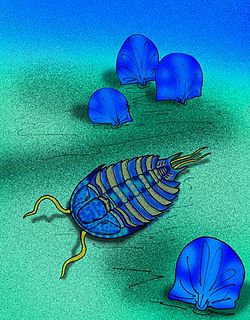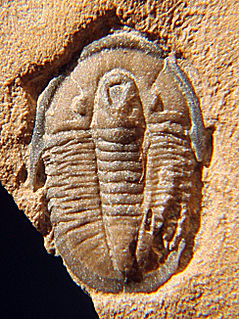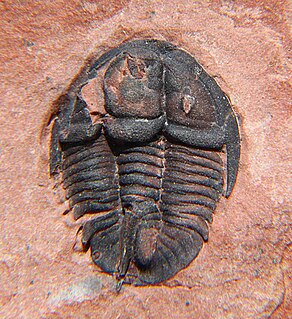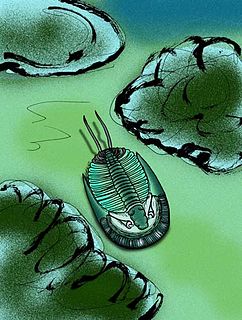Related Research Articles

Calymene Brongniart, 1822, is a genus of trilobites in the order Phacopida, suborder Calymenina, that are found throughout North America, North Africa, and Europe in primarily Silurian outcrops. Calymene is closely related to Flexicalymene, and both genera are frequently found enrolled. Calymene trilobites are small, typically 2 cm in length. The cephalon is the widest part of the animal and the thorax usually has 13 segments.
Eophacops is a genus of trilobites from the order Phacopida, family Phacopidae. These trilobites lived during the Middle Silurian in what now are North America and North-West Europe. Species assigned to this genus can be distinguished from Phacops by their small size (2–3 cm). Eophacops has very large eyes compared to the rest of its body.

Olenoides was a trilobite from the Cambrian period. Its fossils are found well-preserved in the Burgess Shale in Canada. It grew up to 10 cm long.

Asaphus is a genus of trilobites that is known from the Lower and Middle Ordovician of northwestern Europe.

Acaste is a genus of extinct trilobite of the order Phacopida which lived throughout the Silurian period. Though many species had been included, it now has only one species, Acaste downingiae. It is characterized by a convex dorsal surface, an absence of spines, a shortening of the head-shield and a general rounding off of all angles.

Dikelocephalus is a genus of very large trilobites of up to 50 cm (20 in) long, that lived during the last 3 million years of the Cambrian (Sunwaptan). Their fossils are commonly found as disarticulated sclerites, in the upper Mississippi Valley and in Canada (Alberta). The exoskeleton is rounded anteriorly, with the thorax and sides of the tailshield slightly tapering to about ⅔× of the width across the base of the spines at the back of the headshield. At the side corners of the pygidium there may be triangular or hooked spines, pointing backwards, while between the spines the posterior margin is at a 30-75° angle with the lateral margin, gently convex or nearly straight. If pygidial spines are lacking, the margin is gradually rounded. The thorax has 12 segments.

Yunnanocephalus is a genus of ptychopariid trilobite. It lived during the late Atdabanian and Botomian stages, in what are currently Antarctica, Australia and China. It was a "moderately common" member of the Chengjiang Fauna. Yunnanocephalus is the only genus currently assigned to the Yunnanocephalidae family.

Meteoraspis is an extinct genus of ptychopariid trilobites of the family Tricrepicephalidae. The various species lived from 501 to 490 million years ago during the Dresbachian faunal stage of the late Cambrian Period. Fossils of Meteoraspis are characteristic of Late Cambrian strata in North America, though they are found in Late Cambrian strata elsewhere in the world, such as M. nevensis from Victoria Land, Antarctica.

Asaphiscus is a genus of trilobite that lived in the Cambrian. Its remains have been found in Australia and North America, especially in Utah.
Dienstina is a trilobite in the order Phacopida, that existed during the lower Devonian in what is now Germany. It was described by Richter and Richter in 1931, and the type species is Dienstina diensti, which the authors had originally assigned to the genus Phacopidella in 1923. The type locality was in Oberscheld, Rhenish Massif.

Ptychoparia is a genus of ptychopariid trilobites, and is the type genus of the family Ptychopariidae, and the order Ptychopariida.
Entomostracites is a scientific name for several trilobites, now assigned to various other genera.

Angelina Salter, 1859, is a genus of ptychopariid trilobite belonging to the Family Olenidae, Suborder olenina. It lived during the Tremadocian Stage, lowermost of the two standard worldwide divisions forming the Lower Ordovician Series and lowest of the seven stages within the Ordovician System. It encompasses all rocks formed during Tremadocian times, which spanned the interval between 485.4 million and 477.7 million years ago. Fossilized remains of Angelina are known from Wales, Central and South America. It differs from most other Triarthrinae in being larger, with a relatively narrow glabella, the occipital ring poorly defined, and lateral glabellar furrows relatively obscure. Eyes are placed midlength that of the cephalon and the facial sutures converge on the front border at the midline. Species also have long genal spines.
TrilobitesLink, 1807 is a disused genus of trilobites, the species of which are now all assigned to other genera.
ConocephalitesBarrande, 1852, is a disused name for a genus of trilobite, of which the species have now been reassigned to other genera. The name was introduced as a replacement for ConocephalusZenker, 1833, which was unavailable since Thunberg used it in 1815 for a genus of conehead bushcricket. Barrande however was unaware that Conocoryphe had already been proposed by Hawle and Corda in 1847.

Cedaria is a small, rather flat trilobite with an oval outline, a headshield and tailshield of approximately the same size, 7 articulating segments in the middle part of the body and spines at the back edges of the headshield that reach halflength of the body. Cedaria lived during the early part of the Upper Cambrian (Dresbachian), and is especially abundant in the Weeks Formation.

Genevievella is a genus of trilobites with a short inverted egg-shaped outline, a wide headshield, small eyes, and long genal spines. The backrim of the headshield is inflated and overhangs the first of the 9 thorax segments. The 8th thorax segment from the front bears a backward directed spine that reaches beyond the back end of the exoskeleton. It has an almost oval tailshield with 5 pairs of pleural furrows. It lived during the Upper Cambrian in what are today Canada and the United States.

Tricrepicephalus is an extinct genus of ptychopariid trilobites of the family Tricrepicephalidae with species of average size. Its species lived from 501 to 490 million years ago during the Dresbachian faunal stage of the late Cambrian Period. Fossils of Tricrepicephalus are widespread in Late Cambrian deposits in North America, but is also known from one location in South-America. Tricrepicephalus has an inverted egg-shaped exoskeleton, with three characteristic pits in the fold that parallels the margin of the headshield just in front of the central raised area. The articulating middle part of the body has 12 segments and the tailshield carries two long, tubular, curved pygidial spines that are reminiscent of earwig's pincers that rise backwards from the plain of the body at approximately 30°.

Entomaspididae is a family of harpetid trilobites that ranges from the Upper Cambrian to Lower Ordovician of marine strata in China and the United States.

Entomaspis is an extinct genus of harpetid trilobite from Upper Cambrian to Early Ordovician marine strata of the United States. Species are typified by their proportionally large, vaulted, croissant-shaped or bonnet-shaped cephalons that have the cheeks freed to become elongated, curved librigenial spines, and by their comparatively large, crescent-shaped eyes.
References
- 1 2 Sepkoski, Jack (2002). "A compendium of fossil marine animal genera (Trilobita entry)". Bulletins of American Paleontology. 363: 1–560. Archived from the original on 2006-09-05. Retrieved 2008-01-12.
- ↑ Moore, R.C. (1959). Arthropoda I - Arthropoda General Features, Proarthropoda, Euarthropoda General Features, Trilobitomorpha. Treatise on Invertebrate Paleontology. Vol. Part O. Boulder, Colorado/Lawrence, Kansas: Geological Society of America/University of Kansas Press. pp. O249–O250. ISBN 0-8137-3015-5.
- ↑ Palmer, Allison R. (1954). "An Appraisal of The Great Basin Trilobites described before 1900". Geological Survey Professional Paper. Vol. 264-D.